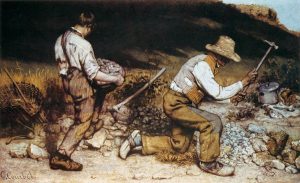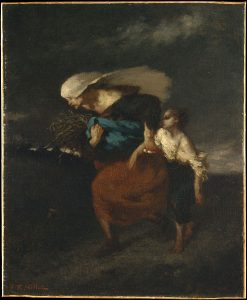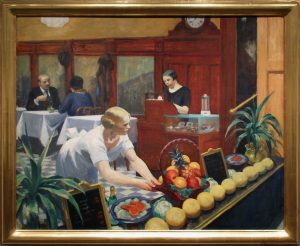In its specific sense realism refers to a mid-19th-century artistic movement characterized by subjects painted from everyday life in a naturalistic manner, without artificiality and avoiding artistic conventions, or implausible, exotic, and supernatural elements.

Image source: https://en.wikipedia.org/wiki/The_Stone_Breakers#/media/File:Gustave_Courbet_-_The_Stonebreakers_-_WGA05457.jpg
Realism is recognized as the first modern art movement, which rejected traditional forms of art, literature, and social organization as outdated in the wake of the Enlightenment and the Industrial Revolution.
Origins
Until the 19th century, Western art was dominated by the academic theory of historical painting and High art (grand manner). Art conventions governed the style and object, resulting in works of art that often appeared artificial and removed from real life. Therefore the development of naturalism began to go hand in hand with a growing emphasis on the realism of the subject, that is, subjects that were outside the tradition of high art.

The term realism was coined by the French novelist Champfleury in the 1840s while in art it was exemplified in the work of the painter Gustav Courbet. By realist subjects, we meant scenes of peasant and working life, life on the city streets, cafes and popular entertainment, and a growing frankness in the treatment of the body and sexual subjects. The term implies a certain grit in the choice of the subject. That argument combined with the new naturalism of treatment caused shock among the upper and middle-class audiences for art.
Realism in Paintings

Gustave Courbet was the first artist to consciously proclaim and practice a realist aesthetic. After his huge canvas, The Studio (1854–55) was rejected by the 1855 Exposition Universelle, the artist exhibited this and other works under the label “Realism, G. Courbet” in a purpose-built pavilion. Courbet was opposed to idealization in his art and urged other artists to instead place the commonplace and contemporary at the center of their art. He regarded the frank depiction of everyday scenes as a truly democratic art. Paintings such as Burial at Ornans (1849) and the Stone Breakers (1849), which he had exhibited at the Salon of 1850–51, had already shocked audience and critics alike for the frank and unadorned factuality with which they depicted humble peasants and workers. The fact that Courbet did not glorify his peasants but presented them boldly and crudely, created a violent reaction in the art world.
Main features of Realism

Each Barbizon painter had their style and specific interests, but in their works all emphasized the simple and ordinary aspects rather than the grandiose and monumental aspects of nature. They moved away from the picturesque melodramatic and painted solid, detailed forms that were the result of careful observation. In works such as The Winnower (1848), Millet portrays peasant laborers with a grandeur and monumentality hitherto that were reserved for more important characters.
Realism Legacy
Realism is considered the beginning of modern art based on its belief that everyday life and the modern world were suitable subjects for art. Philosophically, Realism has embraced the progressive goals of modernism, seeking new truths through the re-examination and overturning of traditional systems of values and beliefs.

Image source: https://search.creativecommons.org/photos/a2db4b14-e732-428b-b722-e0e455ce3fcb by ahisgett
Realism was the first explicitly anti-institutional, non-conformist art movement. Realist painters targeted the customs and social values of the bourgeoisie and the monarchy on who sponsored the art market. Although they continued to present works at the Salons of the official Academy of Art, they did not disdain to set up independent exhibitions to defiantly display their work.
In the wake of the Industrial Revolution, Realism introduced a new conception of the artist as a self-publisher. Gustave Courbet, Édouard Manet, and others purposely courted controversy and used the media to enhance their stardom in a way that continues among artists to this day.
